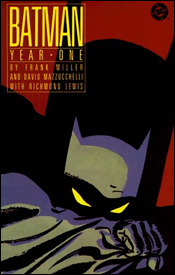 Batman: Year One
Batman: Year One
Collects: Batman #404-407
Writer: Frank Miller
Artist: David Mazzucchelli
By Michael David Sims
I know I'm in the minority, but I've always preferred Batman: Year One over The Dark Knight Returns. Now that's not to say I dislike DKR — quite the contrary, really — it's just that it feels too cluttered for its own good. Set in some strange alternate future that feels too much like a 1980s Troma film — what with the mutants and freaks and near-post-apocalyptic setting that smacks of satire — The Dark Knight Returns would have been so much better if it were kept simple... like Year One.
This simplicity stems from Batman's lack of gadgets and sidekicks; there are no crazed supervillains running rampant (Catwoman is present, but she's hardly "crazed" or "super"), only mobsters and crooked officials; we never see the cave and his only vehicle is a lightweight hang glider that appears once. Then there's Jim Gordon, who's yet to become Batman's greatest ally.
While the official title of the book is Batman: Year One, it's actually meant to showcase the first year in Gotham for both Batman and Gordon — then a Lieutenant fresh from Chicago. Whereas Bruce Wayne has willingly returned home to rid Gotham City of the filth it's blanketed in, Gordon has been transferred here and loathes every minute he has to spend in the stinking, corrupt city. Because the villains aren't lunatic clowns, or district attorney's gone mad, or entombed in life-giving freezer-suits, or made of clay — because they're the morally corrupt men that are charged with protecting us and the mobsters that grease their hands — there's a human element to the story that, sadly, most Batman comic books miss.
Let's face it, the Batman titles are cold and distant because Batman himself is cold and distant. But when Miller stripped all of the villains and toys and calculated distance away he wound up writing a story about two men trying to do what's right in a city that's come to terms with its own corruption. Not just that, but it's a story about a man who doesn't know what to believe in any more and strays from his pregnant wife; it's about two men that were pushed too far and had to fight back on the city's terms, even though they detest every minute of it; it's about standing up for what's right, even if it means dying; it's about being true to one's self, even if it means telling your wife you had an affair or giving away your secret identity to save an innocent life. Never have these characters felt more alive.
Say what you will, but this is more than a Batman comic; remove the cape and cowl (and even Bruce Wayne for that matter) and we're left with a story about a good cop who's all alone in the world, trying to protect a city he was forced into. Slap a hard cover on it, remove David Mazzucchelli's stunning artwork (artwork that clearly inspired the likes of Mike Allred and Alex Maleev) and you've got yourself a novel. Bring the cape and cowl (and therefore Bruce Wayne) back into it, and — not only does it become a comic book again, and therefore (and sadly) less important to the mainstream world — it also becomes a story about a reluctant friendship founded on similar goals. The two men quickly realize they need one another if they're to survive and make waves in the deep, dark ocean that is Gotham City.
When you're done reading Year One you'll come to realize just how Gordon and Batman came to power in Gotham, but when you peel back the translucent layer that's meant to serve as a happy ending (the good guys won, after all) and replace it with continuity, we come to realize that this "feel good" moment can't last forever. We realize the pain that each will suffer — wrought from deaths and the loss of friends, mostly — in the immediate future. We also realize why Gordon is so committed to his job (RE: rocky marriage), and how tormented Bruce Wayne really is.
Over the years these two men have become part of the American (and world) mythos, and as such have become untouchable icons that have been forged into our collective consciousness for nearly a century. That said, Miller opted to ignore all that and brought a fresh perspective to the table, choosing to show Gordon and Batman as nothing more than two men doing their jobs as best they can. No toys or sidekicks or supervillains, just the human element that had been missing all along.

